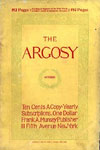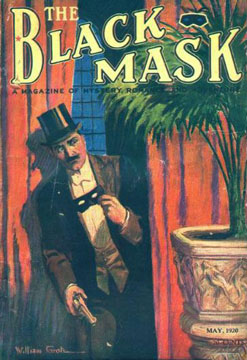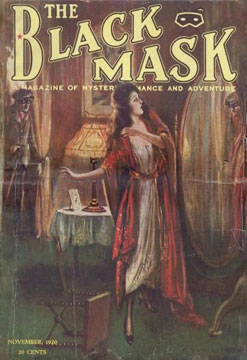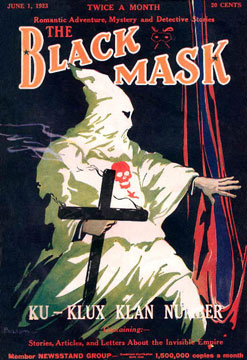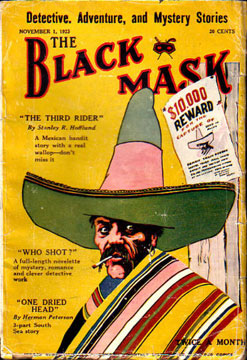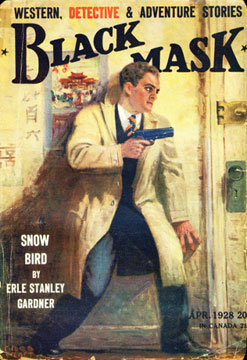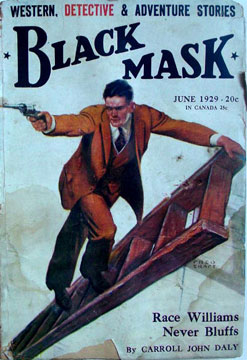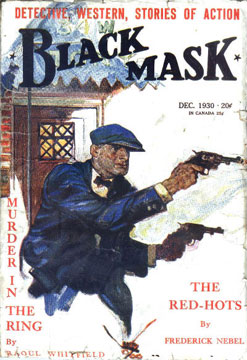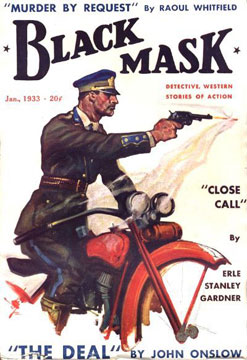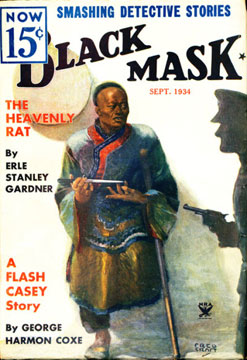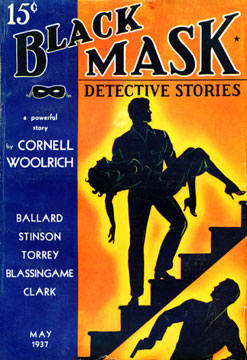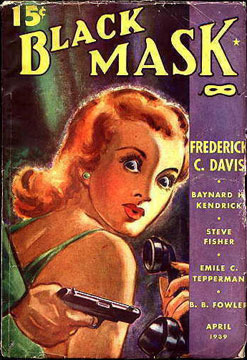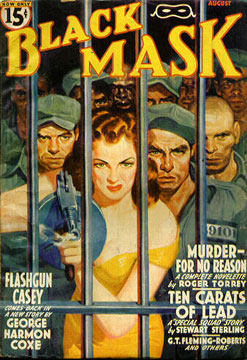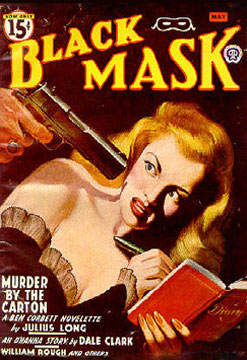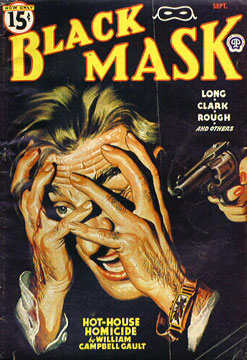The Black Mask
Author's Note: Research for this article was accomplished in Special Collections, University Research Library, UCLA, which holds a fine, but lamentably incomplete, run of Mask—about 90 percent. I wish to acknowledge the aid of the staff. They were, have been, are, and ever will he helpful. I also acknowledge aid, in the form of a small grant, from the Research Committee, College of Arts and Sciences, University of Louisville, Louisville, Kentucky, for Summer 1979.
The debut of The Black Mask in April 1920 was modest and unassuming. It was a monthly pulp, cost 20 cents, contained an even dozen stories, 128 pages, and was subtitled: An Illustrated Magazine of Detective Mystery, Adventure, Romance, and Spiritualism (Mask would consistently tinker with the subtitle). F.M. Osborne was the editor; Pro-Distributors, 25 West 45th Street, New York, the publisher (1).
Although mystery, adventure, romance, and spiritualism were the keynotes of Mask for years to come, occultism would have been more accurate. The logo was a dueling pistol crossed with a dirk, surmounted by a black domino mask. Few readers alive today would recognize one author on the title page, with the exception of Sherlock Holmes scholar Vincent Starrett. The illustrations were black-and-white sketches that were crude, awkward and amateurish enough to be a source of shame for a first-year drawing student.
Dropping "detective" and "spiritualism" from the subtitle for the May 1920 issue, Mask was off and running with a bragging announcement:
The plan of THE BLACK MASK is novel, and yet very simple. What we propose to do is to publish in every issue the best stories obtainable in America.... No effort or expense will be spared... [It] will be illustrated by the best artists we can find.... We will offer more... in one magazine than is now offered in any five.
So the editors upped the number of stories to fourteen and offered "Receipted in Full," by Hamilton Craigie, which was the illustrated lead novelette of 15 pages. Subsequent issues held as many as seventeen tales that were often overwritten, too mysterious, occultish, or just plain silly. The stories were set in exotic locales - Tibet, the South Seas (Mask's favorite), the Philippines, South Africa, the Ivory Coast, Borneo, Burma, India, and San Francisco’s Chinatown (2).
Short-shorts were inevitable, at least one per issue. They ranged from one-half page to two and one-half. Serials began to appear early in 1922. It was not unusual for a writer to appear twice in the same issue either under his own name plus a pseudonym, e.g., Harold Ward [Ward Sterling] (3).
Under Osborne's editorship, quality was apparently not a strong point.
With the October 1922 issue, George W. Sutton, Jr., without fanfare or announcement, took over as editor and H.C. North as associate editor. This was a happening in the life of the pulp which had to have been struggling. Adopting yet another subtitle, A Magazine of Unusual Romance and Detective Stories (back in 1921 it had been A Magazine of Mystery, Thrills and Surprise), Sutton and North had some advice for their readers, in whom they loved to confide:
THE EDITORS... have tried to produce the most unusual magazine in America.... Each story is designed to leave you with a definite, powerful impression…. BUT IN ORDER to get this effect and enjoy it to the fullest you must not read these stories the way you probably read most other fiction tales. If you skip quickly over the pages you will miss the background and the details.... If you read the first paragraphs and then jump to the end... you will cheat yourself.... IT IS OUR AIM to entertain you-to lift you out of the dull routine of daily life.... THE BLACK MASK makes no pretense of sticking to the conventional "happy ending"... its plots are unusual. Its characters are unusual... the endings are always surprisingly out of the ordinary, never commonplace.… You spoil your own pleasure by reading them the wrong end first.
While inviting "the Most Candid Opinions of Our Readers," Sutton put into print some of his new ideas and gimmicks with an eye toward quality. In the October 1922 issue Robert E. Sherwood (not yet the playwright of fame) began a movie-review column, "Film Thrillers." Carroll John Daly made his first appearance in Mask with "Dolly," a story about mental derangement. "A new type of story," Sutton crowed. It was for pulps and it created a real stir. Daly quickly became a star (more on him later), incredible as that may seem to those of us today who know him to have been one of the worst writers who ever lived.
Two of Sutton's gimmicks appeared in the November issue. Joe Taylor, Ex-Automobile Bandit with fifteen years' experience, contributed his first piece (of at least eleven), “The Life of a Hold-Up Man,” complete with mug shot. His words were as suspicious as he was. Eustace Hale Ball, with Earl Derby, contributed the first "Daytime Story" to Mask "Dead Men Do Tell!" "Daytimes" proved to be popular and long-lived. Sutton cautioned that these "awesome" tales were "not to be read at night by people with weak nerves." Nothing could have been more ridiculous, but times change, don't y'know Markham? A similar series, "Cemetery Tales," began early in 1923. Drayton Dunster's "The Tombstone of Babette," (March 15) was typical (4).
Sutton was fond of serials and was not above having two in the same issue. That way, of course, he was assured that readers could not "jump to the end" except in the final installment. He was overly fond of a true-crime series called "The Manhunters" written by Charles Somerville ("the most celebrated reporter and investigator of real mystery and crime in America"). The first segment, "After Ten Thousand Miles," came out in February 1923. "Manhunters" was as much serial as it was series (5).
The big moment in Black Mask's early days, although the editors did not know it at the time, was the advent of Peter Collinson with "The Road Home," a three-page adventure short-short (December 1922). Collinson was none other than Samuel Dashiell Hammett. By the end of 1923, Collinson/Hammett had appeared eight times, twice in one issue. The first Continental Op story, "Arson Plus," (October 1) was under Hammett's nom de plume. What began as a professional relationship became an affaire de coeur. No other words can describe Mask's esteem and worship.
Hammett's letters began to appear as early as October 15, 1923, when he discussed "Slippery Fingers" and the transference of fingerprints. In the issue of November 15, Mask proudly announced the forthcoming "Bodies Piled Up" (December 1), an Op caper:
Mr. Hammett has suddenly become one of the most popular of [The] Black Mask writers, because his stories are always entertaining, full of action and very unusual situations. This is his best to date - a real detective yarn.
In the head note to "The House on Turk Street," April 15, 1924, the editor of Mask wrote: "We wouldn't consider an issue complete without one of Mr. Hammett's stories in it." On and on they went. When Black Mask unexpectedly rejected "Women, Politics and Murder," Sutton printed Hammett's reaction, August 1924:
The trouble is that this sleuth of mine [The Op] has degenerated into a meal-ticket. I liked him at first and used to enjoy putting him through his tricks; but recently I've fallen into the habit of bringing him out and running him around whenever the landlord... shows signs of nervousness. There are men who can write like that, but I am not one of them.
Hammett rewrote "Women" and Mask published it the next month. The Op wasn't abandoned until November 1930. When Hammett's "The Golden Horseshoe" appeared, the head note trumpeted:
In our recent voting contest for [the readers'] favorite BLACK MASK authors, Dashiell Hammett received thousands of votes because of his series of stories of the adventures of his San Francisco detective. He has created one of the most convincing and realistic characters in all detective fiction (November 1924).
Hammett submitted an autobiographical sketch in the back matter. "I am long and lean and gray-headed, and very lazy. I have no ambition at all in the usual sense of the word." Meanwhile, to retrace our steps, Black Mask had become a semimonthly as of February 15, 1923. "This move was dictated entirely by our readers and by the newsdealers," Sutton insisted. "A bond of cordial good feeling exists between our readers and us. They guide us in everything we do in Black Mask."
On June 1, 1923, Mask produced its supreme achievement. The Ku Klux Klan number. Disclaiming any "connection whatsoever" with the hooded ones, Mask immodestly opined that the issue might prove to be "the most interesting and sensational number of any American magazine this year." They were "ABSOLUTELY NEUTRAL" but thought "the attempt to revive the old... Klan with new ideas and purposes was the most picturesque element that has appeared in American life since the war." The staff even boasted of the cover by L.L. Balcom. Each story centered on the KKK. The Mask claimed:
SOME OF THESE FAVOR THE KLAN-OTHERS ARE STRONGLY AGAINST IT-WE REPEAT, WE ARE ABSOLUTELY NEUTRAL.
Reader letters (both pro and con) poured in, prompting the establishment of a KKK Forum (August 15 issue). The Forum divided the letters into two parts: For and Against. No "libelous" or "malicious" letters would be printed.
Taking a close look at the effort and the uproar that followed, one gets the distinct impression that Mask supported and upheld the Klansmen and that it favored their racism and vigilantism. No other argument seems logical.
Really, the most significant item in the issue was Carroll John Daly's "Knights of the Open Palm," featuring the following introduction to Race Williams, Private Investigator:
... That's what the gilt letters spell across the door of my office. It don't mean nothing, but the police have been looking me over so much lately that I really need a place to receive them.... As for my business, I'm what you might call the middleman — just a halfway house between the dicks and the crooks (33).
Derived from an earlier Daly creation, "Three-Gun Terry Mack, Private Investigator" (see May 15, 1923), Williams went on in Mask to become (I believe, I am safe here) the most popular character of them all, out-rivaling even The Op. Daly knew when he had a good thing going and he rarely missed. In the same issue in which Hammett discussed himself (November 1924), Daly had a few words of his own:
About Race Williams-he is a combination of fact and fiction; it is hard to tell where the one ends and the other leaves off. To my mind he is the hero of reality-not the proud fiction hero who shoots only when first wounded by an enemy.
So be it.
Mask ceased semi-monthly publication with the April 15, 1924 issue and went back to monthly. By then, Sutton was out and P.C. Cody was editor as well as vice president and circulation manager (6). But before dismissing Sutton's tenure, we must acknowledge his fetching one more star into his galaxy - Charles M. Green, Erle Stanley Gardner, who began with "The Shrieking Skeleton" (December 15, 1923), followed up with "The Serpent's Coils" (January 1, 1924), which was a Daytime Story, and continued well into the 1940s. He, too, quickly established his fame among the readers and just as quickly dropped "Green." Before long he began his Bob Larkin tales and in January 1925 had printed "Beyond the Law," the first novelette with Ed Jenkins, The Phantom Crook, who was to do a lot of work in Frisco's Chinatown. Jenkins was no slouch. He held his own with The Op and Race Williams. By the end of 1926 he had been in eleven stories.
The magazine thrived under Cody, for he was an editor with ideas. In the Summer of 1924, he bade his readers to be his associate editors, that is, to tell him what they wanted for the upcoming November number. In August he wrote: "We are publishing the magazine for you, to give you pleasure. We wish to make it exactly the kind of magazine you wish it to be."
Cody and the readers put out a good one: Race Williams led the issue, followed by The Op ("The Golden Horseshoe"), and Francis James with a Prentice story; and finally, yet another debut, J. Paul Suter's The Reverend McGregor Daunt ("one of the strangest and most fascinating characters in fiction"). Suter played the game well. On page 118 was a letter from the good Reverend himself! Daunt may not have been at the top with, say, The Op or Ed Jenkins, but he was up there.
In March 1926, Cody informed the faithful that:
[T]he rapid increase in the sale of THE BLACK MASK… has induced us to increase our print order by 50 percent-at one shot.... Will you help us out? All you need to do is to tell a friend or two about the magazine.
And he hammered at "telling" for some months. Come September, he was satisfied. He offered his "Many Thanks" and said unto all: "There isn't a he-man who likes he-man stories who won't be grateful to the fellow who tells him about The Black Mask." He offered free sample copies.
The time had come for Joseph T. Shaw, and in he came with the November 1926 issue. As editor he brought fame to Mask and himself. Or was it the other way around? Let's face it. Shaw inherited from his predecessors; indeed, he was more an heir than a successor. In place in the pulp heavens were The Stars; in place was the action story he loudly professed to love; in place was the Western. A new name had been found, Raoul F. Whitfield, from whom so much was to come. "Cap" Shaw had the talent and the sense of a superb editor, but he did not do it alone. Nor did he veer more than a fraction from the policies of Osborne, Sutton, and Cody during his reign (1926-1936), precisely ten years. Only names and faces changed with passing time, not editorial policy.
"We will offer more," promised Osborne back in 1921. He abided by it.
So did Sutton and Cody, qualitatively. Many writers vied for inclusion in The Black Mask. More often than not, they or their characters appeared exclusively therein. Writers seemed, obviously so, to like writing for the magazine. As Hammett wrote when "Women, Politics and Murder" had been returned:
I want to thank [you] for jolting me into wakefulness. There's no telling how much good this will do me. And you may be sure that whenever you get a story from me hereafter - frequently, I hope – it will be one I enjoyed writing.
That says it. Says it all.
Edward R. Hagemann, UCLA
Notes
1. Immediately we are presented with a mystery, for the 45th Street address was also that of The Smart Set, the famous magazine (also a pulp) edited by H.L. Mencken and George Jean Nathan. Indeed, HLM contended that he and Nathan "started Black Mask.... It... was a success.... Nathan and I sold our interest in it to [Eltinge F.] Warner and [Eugene F.] Crowe after running it for six months" (quoted from Betty Adler, compiler, HLM: The Mencken Bibliography [Baltimore, 1961], (p. 138). Warner was publisher of and Crowe part owner of The Smart Set. If in fact HLM and Nathan ran Black Mask there is no evidence on the masthead.
2. Simply put, Mask was racist and used Chinese, in stories and on covers, derogatorily. Almost always they were villains. Blacks, if they appeared at all, were rendered as clowns.
3. Pseudonyms are a real problem. Undoubtedly there was much of this practice and most will never be known unless, by chance, the Mask records are located. I have the distinct feeling that in the early days an issue might have been written by a handful of authors, maybe three or four.
4. Gimmicks were not altogether new with Sutton. Under Osborne, a short-lived, illustrated "department" devoted to fingerprints, conducted by one William Starwood Post, F.P.E. (Finger Print Expert?), commenced in May 1922. While I'm at it, I'll give Osborne his due for running a five-part serialization of J.S. Fletcher's "Exterior to the Evidence", April-August 1922, and for printing an early Murray Leinster story, "The Frankenstein Twins" (June 1922).
5. Two other featured series contributed to the compartmentalization of Mask. "Our Dreams," a.k.a. "Your Own Mysteries," was under the byline of Gregory Stragnell, M.D. Sutton called the column "a practical, helpful application of one of the newest sciences—psychoanalysis." It began on March 1, 1923, but didn't last long. Readers were not yet ready for a shrink, despite Sutton's plea to send in "your dreams... tell Dr. Stragnell your worries and problems."
6. One of Cody's first moves was to change the style of the cover to more like those of the classic Masks in the late 1920s and early 1930s. On page 52 of the April 1, 1924 issue, he put up the cover painting for auction to the highest bidder. "Bids of less than $10.00 will... be rejected. No printing of any kind appears on these original paintings."
Dr. Hagemann's article, subtitled "The Magazine Dedicated to Readers of Mystery, Suspense, Thrillers, and Adventure," was originally published in Mystery January 1981, Vol. 2, No. 1.
© 1981, Professor Edward R. Hagemann. Copyright is retained by the heirs of Dr. Hagemann's estate.
